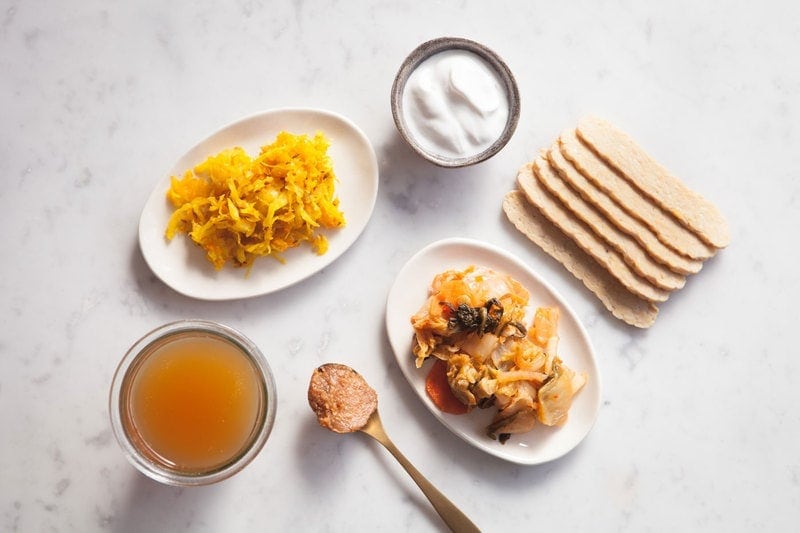
Gut health is a topic dear to me, having had an autoimmune condition (Inflammatory Bowel) myself. My poor digestive system’s first assault was a small bowel infection called Tropical Sprue, picked up while living in Indonesia as a toddler. Add to that a childhood filled with antibiotic use, and a severe case of food poisoning (campylobacter) later in life, with a lot of stress thrown in for good measure, and it was no surprise it eventuated to a full blown autoimmune disease. A healthy gut is the foundation of good health, and gut conditions are at the root of many seemingly unrelated imbalances – think allergies, eczema, rheumatoid arthritis, to name a few. I’m happy to report that through careful attention to managing stressors and diet, in combination with some very powerful herbal allies, I’m feeling more robust than I have in years. I credit part of my health maintenance to the inclusion of fermented foods in my daily diet.
There are near on hundreds of fermented foods to chose from, across all cultures, but today I’m sharing my top favourites. I've chosen them as they're either readily available or easy enough to make at home.
[bctt tweet="The top fermented foods for gut health you need to be eating! Read more here."]
How to boost your intake of beneficial probiotics with fermented foods
Fermented foods are an easy way to incorporate more beneficial probiotics into your diet, to help improve the ecology of your gut. The gut microbiota regulates the immune system, so it is particularly important to ensure the right balance of bacteria reside there. Alterations within these microbial communities can cause immune dysregulation, increasing the risk of autoimmune disorders [1]. Traditional communities all over the world have been using fermented foods for thousands of years. Now, let's have a look at some of the top sources of probiotic rich foods...
1. Yoghurt – from Turkey
Yoghurt is cultured dairy milk, and is by far the most commonly consumed probiotic food in New Zealand & Australia. However, research suggests that the type of bacteria typically within yoghurt is not actually that therapeutic [2]. This is why many brands are adding specialty strains to their products. For those with a dairy sensitivity, coconut yoghurt is a great alternative. You can make your own at home by blending the flesh of young coconuts together to make a cream, then adding a probiotic capsule and leaving to culture for 24 hours. In making homemade yoghurt this way, you can control how much added sugar (if any) goes in to the final product.
Try my recipe for homemade Raw Coconut Yoghurt here.

2. Sauerkraut – from Germany
Sauerkraut is ‘sour cabbage’. During fermentation, the sugars and starches in the cabbage are converted to lactic acid bacteria, allowing beneficial bacteria to then proliferate. The lactobacilli in fermented foods such as sauerkraut enhance their digestibility and increase vitamin levels [3]. You can easily prepare sauerkraut at home with an array of vegetables – cabbage, beets, turnips, herbs and even grape leaves. Pictured below is a kraut made with fresh turmeric.
Try my recipe for Spiced Sauerkraut here.
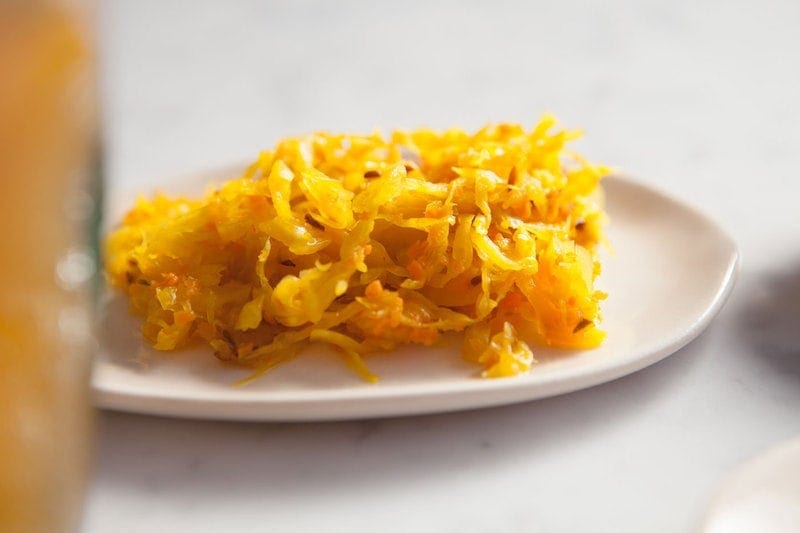
3. Kimchi – from Korea
Kimchi is a traditional Korean dish. It is typically made from fermented vegetables such as Nappa cabbage, radish, cucumber and carrot, spiced heavily with chilli, garlic, leek and ginger. This functional food is high in both prebiotics and probiotics, dietary fibre, vitamins, minerals and antioxidants [4]. Prebiotics may simply be described as non-digestible foods that, upon ingestion, selectively provide food for the growth of beneficial probiotics – in particular, lactobacilli and bifidobacteria [4]. Like all fermented foods, Kimchi contains a diverse number of beneficial microorganisms. One of the most prominent strains, Lactobaccillus plantarum, has been shown to reduce symptoms of irritable bowel syndrome [5]. Kimchi is usually very hot. You can buy it from supermarkets and health foods stores, or make it yourself at home. Enjoy a tablespoon or two with main meals.
Try my homemade Kimchi for Chilli Wimps recipe here.

4. Kefir – from Turkey
Kefir is a fermented milk, similar to yoghurt. Kefir is derived from the Turkish word keyif, meaning “feels good”. It is a functional food that was discovered by the nomads and wanderers in the Middle East, some 10,000 years ago. They carried milk in pouches made from animal skins for nourishment, where it readily fermented. Small white ‘grains’ formed as the colonies of yeast and lactic-acid bacteria grew and clumped together, which are still known today as kefir grains. The Lactobaccillus species of microbes are usually always present [6]. The lactobacilli isolated from kefir grains have shown antimicrobial action against various pathogens, and inhibit the growth of Candida albicans [6]. You will find kefir drinks at health food stores and natural supermarkets. You can also purchase your own kefir grains and culture some milk or coconut water at home.
Pictured below are the water kefir grains from my Pineapple Coconut Water Kefir recipe.

6. Kombucha – from China
Kombucha is a beverage made from fermenting green or black tea with sugar and a starter culture known as a SCOBY – an acronym for a Symbiotic Colony of Bacteria and Yeast. It originates from China as far back as the Tsin Dynasty some 2,000 years ago, where it was revered as the ‘tea of immortality’. Kombucha is said to have a positive effect on the gut microflora of humans, its acetic acid content enabling it to exert antimicrobial effects against pathogens such as Heliobacter pylori (the bacteria responsible for stomach ulcers and gastritis) and Escherichia coli [7]. Kombucha can be found in most health food stores and natural supermarkets. You can make your own at home with a SCOBY, a few tea bags and a small amount of cane sugar [8]. The sugar feeds the SCOBY and for the most part, is negligible once fermentation is complete, creating a fizzy and slightly tart drink.
Learn how to make Kombucha with my simple guide, here.
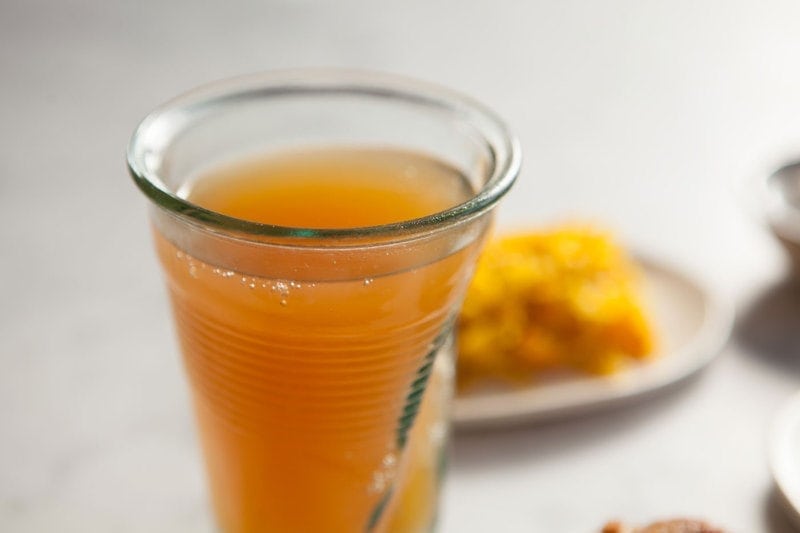
6. Miso – from Japan
Miso is a fermented soybean paste originating from China and Japan. It is nutritionally a good source of minerals and some B vitamins [9]. Miso comes in many varieties, ranging in colour and depth of flavour. Typically, the lighter varieties are made with a blend of soybeans and white rice. Light brown pastes are made from soybeans with barley and/or buckwheat, and the darker pastes from soybeans and brown rice. Miso is often used as a base for a soup or broth. In macrobiotic cooking, it is added right at the very end, so the delicate probiotics are still viable (they are heat sensitive). Miso is very salty so should be enjoyed in moderation [9].
Try using miso in a recipe, like these healthy Raw Vegan Kofta, here.

7. Tempeh – from Indonesia
Tempeh is a favourite as it is such a good source of plant-based protein. Tempeh is actually a culinary mold culture, grown on soybeans. According to fermentation master Sandor Katz, the mold (Rhizopus oligosporus) pre-digests the beans and binds them together into a solid cake, greatly reducing the cooking time [10]. In the process, nutrients in the soy beans are transformed. For example, proteins become more digestible and minerals more bioavailable. In fact, it is said that the calcium in tempeh is equally well absorbed as calcium from cow’s milk [11]. When I think tempeh, I think of Japanese cuisine, but it appears to have first been prepared in Java, Indonesia. Being a soy product, you want to make sure that you are purchasing an organic and non-GMO brand. An easy way to prepare tempeh is to slice it into thin strips, marinate or simply fry in a little oil. Delicious cut into cubes as kebabs, or as a side with your salad.
Try this delicious Ginger, Sesame & Maple Marinated Tempeh recipe here.

SUMMARY
Of course, this is just a small ‘taster’ of the many wonderful fermented foods on offer to us. Others include umeboshi plums, beet kavaas, pickles, fermented taro root, mead, ginger beer and even sourdough. There are many great resources available to help educate on and inspire in the kitchen. Two of the best books include Sally Fallon’s Nourish Traditions cookbook [3] and Sandor Ellix Katz’s The Art of Fermentation [10].
Finally - reach out to your local community if you're after a starter culture - type 'fermentation' and your city name into facebook's search field and look for a group you can join. There are many great, supportive groups out there that help each other troubleshoot and of course, share their delicious recipe variations.
Happy fermenting!
digestive distress?
Gut health is a particular area of interest to me professionally as a Naturopath, Medical Herbalist and Holistic Nutritionist. If you have a digestive imbalance and would like to address the root cause, you may like to consider seeing me in clinic as a client.
Please visit my practitioner website laurenglucina.com for more, or make a booking via the consultations page here.
Enjoy this post? I’d love you to share it!
References:
-
Wu, H-J., & Wu, E. (2012). The role of gut microbiota in immune homeostasis. Gut Microbes, 3(1), 4-14. doi: 4161/GMIC.19320
-
Braun, L, & Cohen, M. (2015). Herbs & natural supplements: An evidence-based guide (4th ed., Vol. 2). Sydney, Australia: Churchill Livingstone
-
Fallon, S., & Enig, M.G. (2001). Nourishing traditions: The cookbook that challenges politically correct nutrition and the diet dictocrats (2nd). Washington, DC: NewTrends Publishing, Inc.
-
Jung, J.Y., Lee, S.H., & Jeon, C.O. (2014). Kimchi microflora: History, current status, and perspectives for industrial kimchi production. Applied Microbiology and Biotechnology, 98(6), 2385-2393. doi: 1007/S00253-014-5513-1.
-
Ducrotté, P., Sawant, P., & Jayanthis, V. (2012). Clinical trial: Lactobacillus plantarum 299V (DSM 9843) improves symptoms of irritable bowel syndrome. World Journal of Gastroenterology, 18(30), 4012-4018. doi: 3748/WJG.V18.I30.4012
-
De Oliveira Leite, A. M., Miguel, M. A. L., Peixoto, R. S., Rosado, A. S., Silva, J. T., & Paschoalin, V. M. F. (2013). Microbiological, technological and therapeutic properties of kefir: a natural probiotic beverage.Brazilian Journal of Microbiology, 44(2), 341–349. doi: 1590/S1517-83822013000200001
-
Greenwait, C.J., Ledford, R.A., & Steinkraus, K.H. (1998). Determination and characterization of the anti-microbial activity of the fermented tea Kombucha. Food and Science Technology, 31(3), 291-296
-
Wellness Mama. (2016). Continuous brew kombucha. Retrieved from http://wellnessmama.com/8638/continuous-brew-kombucha/
-
Murray, M., Pizzorno, J., & Pizzorno, L. (2005). The encyclopedia of healing foods. New York: Atria Books
-
Katz, S.E. (2012). The art of fermentation: An in-depth exploration of essential concepts and processes from around the world. White River Junction, VM: Chelsea Green Publishing
-
The George Mateljan Foundation. (2001-2016). Retrieved from http://www.whfoods.com/genpage.php?tname=foodspice&dbid=126

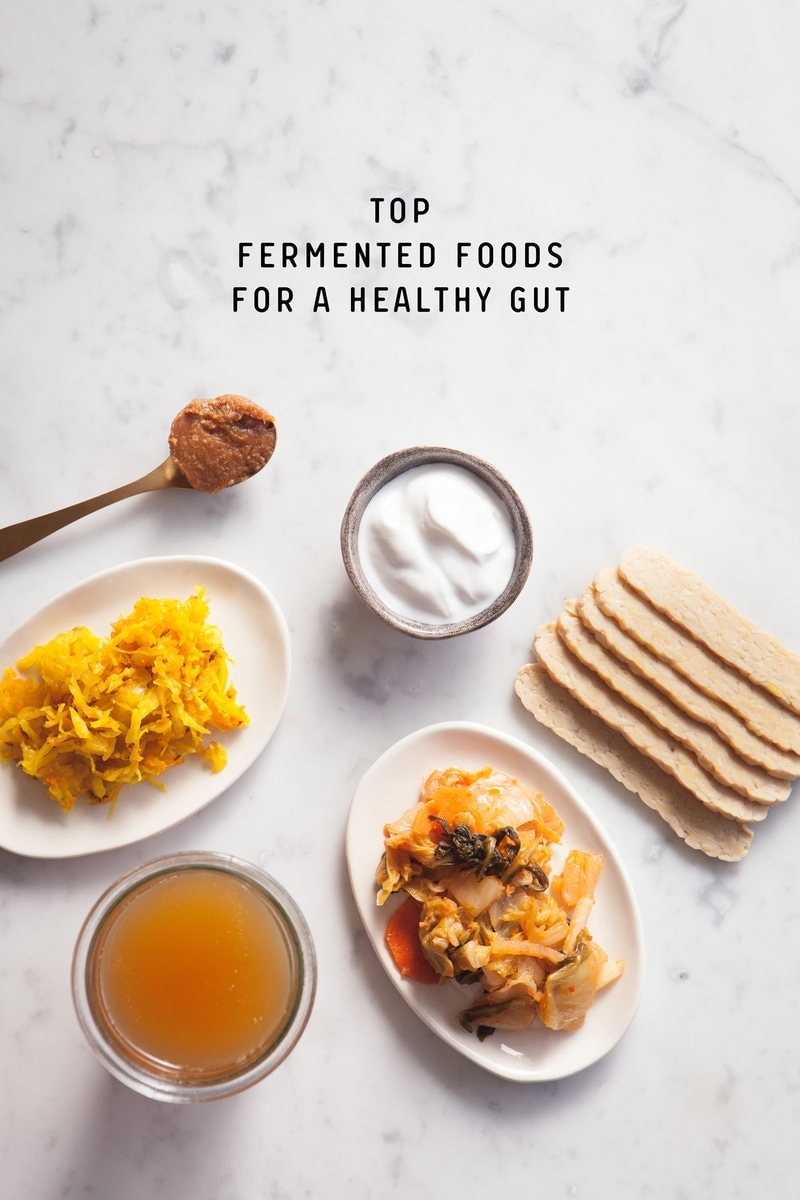


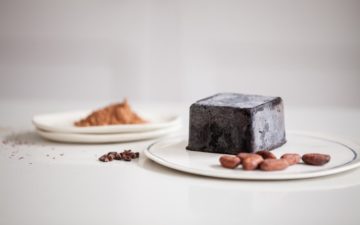
Hannah Phoebe Bowen
Love all these foods but I'm especially obsessed with tempeh, just fried or roasted in coconut oil though - I'd love love love to see you share your fave tempeh recipes xx
Ascension Kitchen
Hi lovely. Me too - the bestest recipe I've tried has been tempeh skewers coated in gado gado sauce - eeeep! Hopefully I can get one to the blog soon, hope you're well x